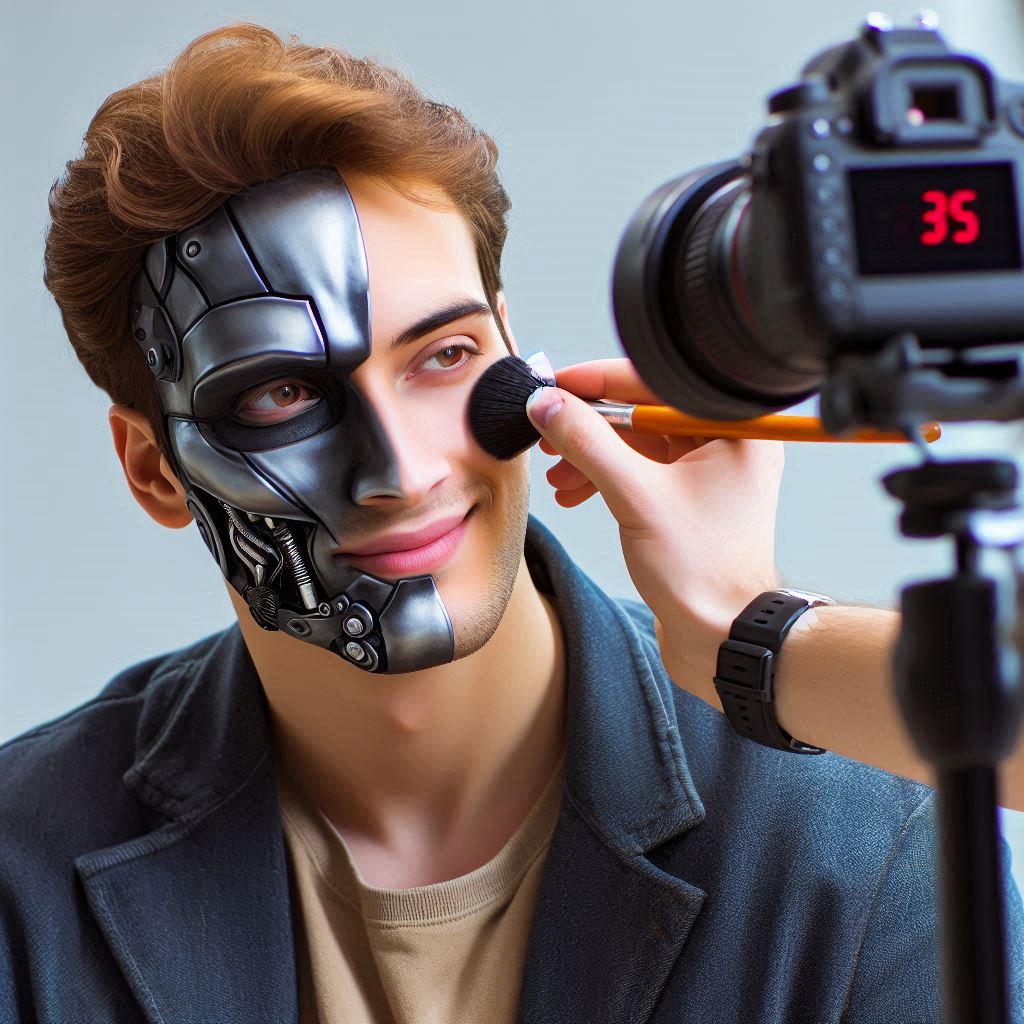Introduction
Special effects (SFX) makeup and prosthetics are fascinating art forms.
They transform actors into creatures, monsters, or otherworldly beings.
This craft is popular in movies, television, and theater.
From horror films to fantasy epics, SFX makeup plays a crucial role in storytelling.
The entertainment industry relies heavily on these effects to create immersive experiences.
SFX artists use various techniques to make characters come to life.
Prosthetics, like fake wounds and facial alterations, enhance realism and add depth to performances.
For beginners, learning SFX makeup and prosthetics can seem daunting.
This field requires a blend of artistic skill and technical knowledge.
Proper guidance is essential for mastering the basics and advancing to more complex techniques.
Understanding foundational skills, such as applying prosthetics and blending makeup, sets the stage for creating convincing effects.
As interest in this field grows, aspiring artists benefit from structured learning.
Beginners should focus on learning essential techniques and practicing regularly.
Gaining proficiency in SFX makeup and prosthetics opens doors to exciting opportunities in entertainment.
By starting with the right guidance, you can develop your skills and make your mark in this dynamic industry.
What is SFX Makeup?
SFX makeup, short for special effects makeup, is a form of makeup used to create realistic and fantastical looks for film, television, theater, and other media.
It involves techniques and materials that go beyond traditional makeup to transform an actor’s appearance.
Define SFX makeup and prosthetics
SFX makeup refers to the use of prosthetic appliances, makeup, and other tools to create characters with various injuries, wounds, or other special effects.
Prosthetics are artificial body parts or cosmetic enhancements, such as latex appliances, silicone prosthetics, and foam latex pieces, used to alter an actor’s appearance.
Difference between traditional makeup and SFX makeup
The main difference between traditional makeup and SFX makeup lies in their purpose and materials.
Transform Your Career Today
Unlock a personalized career strategy that drives real results. Get tailored advice and a roadmap designed just for you.
Start NowTraditional makeup focuses on enhancing natural beauty and creating everyday looks, while SFX makeup aims to create illusions, transformations, and special effects.
SFX makeup uses professional-grade materials like prosthetics, sculpting tools, and specialized paints to achieve realistic and otherworldly effects not possible with traditional makeup alone.
Examples of popular SFX makeup looks in movies and TV shows
SFX makeup artists have created iconic looks in various films and TV shows, showcasing their skills and creativity.
Some popular examples include:
- The Joker’s scars and makeup in “The Dark Knight”
- Michael Myers’ mask in “Halloween”
- The White Walkers’ prosthetic makeup in “Game of Thrones”
- The alien creatures in “Men in Black”
- The zombie makeup in “The Walking Dead”
These examples highlight the versatility and impact of SFX makeup in bringing fictional characters and creatures to life on screen.
Read: Freelancing vs. Studio Jobs for SFX Artists
Essential Tools and Products
Essential Tools for SFX Makeup
- Makeup Brushes: Different sizes and shapes for creating detailed designs.
- Sponges: Used for blending and applying makeup evenly on the skin.
- Mixing Palette: To mix different colors and products for custom effects.
- Spirit Gum: Adhesive used to attach prosthetics and special effects pieces.
- Liquid Latex: Essential for creating wounds, scars, and other textured effects.
- Fake Blood: Different types available for realistic-looking injuries and gore.
- Setting Powder: Helps keep makeup in place and reduces shine.
- Cotton Swabs and Rounds: Used for makeup application and detailing.
- Makeup Remover: Gentle but effective product to remove makeup easily.
- Disposable Gloves: Ensure hygiene and prevent cross-contamination.
Types of Prosthetics and Special Effects Products
- Foam Latex Prosthetics: Lightweight and flexible for realistic effects.
- Silicone Prosthetics: Durable and lifelike for professional results.
- Gelatin Prosthetics: Budget-friendly option for creating wounds and textures.
- Latex Appliances: Pre-made pieces for quick and easy application.
- Scar Wax: Ideal for sculpting wounds, cuts, and deformities.
- Silicone Gel: Used for creating scars, burns, and skin textures.
- Alcohol-Activated Makeup: Waterproof and long-lasting color for FX.
- Prosthetic Adhesives: Ensures secure attachment of prosthetics to skin.
- Mold Making Kits: For custom prosthetic creation and duplication.
- Fake Teeth and Eyes: Enhance character creation with realistic features.
Beginner-Friendly Brands and Products Recommendations
- Mehron: Offers a wide range of SFX products for beginners to professionals.
- Ben Nye: Known for their quality makeup products, suitable for beginners.
- Kryolan: Provides a variety of makeup and prosthetic products for all skill levels.
- Graftobian: Affordable yet professional products for beginner SFX artists.
- Cinema Secrets: Trusted brand with beginner-friendly SFX products and kits.
- European Body Art: Known for their durable and high-quality SFX products.
- Wolfe FX: Offers vibrant colors and easy-to-use products for beginners.
- Skin Illustrator: Alcohol-activated makeup suitable for all levels of SFX artists.
- Woochie by Cinema Secrets: Pre-made prosthetics for quick and easy application.
- Reel Creations: Specializes in waterproof and long-lasting SFX products for beginners.
Investing in quality tools and products is essential for mastering SFX makeup and prosthetics.
Experiment with different brands and products to find what works best for your skills and creations.
Remember, practice makes perfect, so don’t be afraid to try new techniques and effects to enhance your skills in special effects makeup.
Read: Day in the Life of a Special Effects Makeup Artist

Basic Techniques
The basic techniques of SFX makeup
When diving into the world of SFX makeup and prosthetics, it’s essential to grasp the basic techniques that form the foundation of this art form.
Sculpting
One of the fundamental skills in SFX makeup is sculpting, where artists create molds for prosthetics.
Beginners should start with basic sculpting tools like clay to shape their designs.
Practice sculpting different textures and shapes to enhance your skills and creativity.
Molding
After sculpting, the next step is molding, which involves creating a negative of your design.
Silicone and alginate are popular materials used for molding in SFX makeup.
Learn how to properly mix and pour molding materials to achieve the desired results.
Painting
Painting is a crucial aspect of SFX makeup, as it brings your creations to life.
Invest in high-quality paints and brushes to ensure realistic effects in your designs.
Experiment with different painting techniques like stippling and airbrushing for varied results.
Transform Your Career Today
Unlock a personalized career strategy that drives real results. Get tailored advice and a roadmap designed just for you.
Start NowTips for Beginners
Creating realistic effects in SFX makeup requires practice, patience, and a willingness to learn from mistakes.
Here are some tips for beginners:
- Start with simple projects to build your skills before attempting complex designs.
- Study anatomy to understand how to create believable wounds, bruises, and other effects.
- Watch tutorials and seek guidance from experienced artists to learn new techniques.
- Practice blending colors and textures to achieve seamless transitions in your makeup looks.
- Don’t be afraid to experiment and push the boundaries of traditional makeup techniques.
Step-by-Step Instructions
Here is a simple SFX makeup look that beginners can try to practice the basic techniques mentioned above:
- Start by sculpting a small wound using clay to understand the process of shaping prosthetics.
- Create a mold of your sculpted design using silicone or alginate to learn the molding technique.
- Once the mold is ready, carefully pour latex or gelatin to create the prosthetic piece.
- Paint the prosthetic with skin-toned colors and use fake blood to add realistic details to the wound.
- Apply the prosthetic to your skin using adhesive and blend the edges seamlessly with your natural skin.
- Finish off the look with makeup to enhance the overall effect and create a cohesive appearance.
Remember, practice makes perfect, so don’t be discouraged by initial setbacks.
Keep honing your skills and experimenting with different techniques to become a master of SFX makeup and prosthetics!
Read: Famous SFX Artists You Should Know About
Safety Precautions
When diving into the world of SFX makeup and prosthetics, it‘s crucial to prioritize safety above all else.
Here are some key points to keep in mind:
Importance of Practicing Safety Measures
- Always perform a patch test before applying any new products to check for allergic reactions.
- Ensure proper ventilation in your workspace to avoid inhaling fumes from products like adhesives or paints.
- Use clean tools and brushes to prevent bacterial contamination on your skin.
- Follow manufacturer instructions for each product to avoid misuse or adverse reactions.
Common Allergies and Sensitivities
- Latex: Many prosthetic pieces are made from latex, which can cause allergic reactions in some individuals.
- Glues and adhesives: Some people may be sensitive to the chemicals in these products, leading to skin irritation.
- Alcohol-based products: These can dry out and irritate the skin, especially with frequent use.
Proper Storage and Disposal
- Keep SFX makeup products in a cool, dry place away from direct sunlight to prevent them from spoiling or melting.
- Check the expiration dates on all products and dispose of any that are past their prime to avoid skin reactions.
- Empty containers should be rinsed thoroughly before recycling to prevent contamination of other materials.
By following these safety precautions, you can enjoy experimenting with SFX makeup and prosthetics while protecting your skin and overall well-being.
Read: Top Multimedia Art and Design Competitions
Practice Makes Perfect
The need for practice and experimentation in mastering SFX makeup techniques
When it comes to SFX makeup and prosthetics, practice truly makes perfect.
As a beginner, it’s important to dedicate time to experimenting with different techniques and materials.
This hands-on approach will help you develop your skills and gain confidence in your abilities.
Ways for beginners to hone their skills
One of the best ways to improve your SFX makeup skills is by watching tutorials from experienced artists.
These videos can provide valuable insights and tips that you can implement in your own work.
Additionally, attending workshops or classes can also help you learn new techniques and receive feedback from professionals.
Encouragement to start with simple projects and gradually progress to more complex looks
Starting with simple projects is key for beginners.
Focus on mastering basic techniques, such as creating wounds or bruises, before moving on to more complex looks like full face transformations or fantastical creatures.
By building a strong foundation, you’ll be better equipped to tackle challenging projects in the future.
Remember, Rome wasn’t built in a day, and neither is mastery of SFX makeup.
Transform Your Career Today
Unlock a personalized career strategy that drives real results. Get tailored advice and a roadmap designed just for you.
Start NowBe patient with yourself and allow room for growth and improvement.
With consistent practice and a willingness to experiment, you’ll be amazed at how much progress you can make in a relatively short amount of time.
Building a Portfolio
In the world of SFX makeup and prosthetics, having a solid portfolio is essential for showcasing your skills and attracting potential clients.
Here are some tips to help you build a strong portfolio:
Importance of Creating a Portfolio
A portfolio serves as a visual representation of your work, allowing potential clients and employers to see your skills and creativity.
It is a way to showcase your unique style and abilities in SFX makeup and prosthetics.
Documenting and Displaying SFX Makeup Looks
Make sure to take high-quality photos of your SFX makeup looks in different angles and lighting conditions.
Use a variety of close-up shots, full-face shots, and before-and-after pictures to highlight the details of your work.
Create a digital portfolio that is easy to navigate and showcases a diverse range of your SFX makeup skills.
Consider creating a physical portfolio as well, such as a book or printed photos, to leave a lasting impression on potential clients.
Networking with Industry Professionals
Attend industry events, workshops, and conventions to network with other SFX makeup artists and industry professionals.
Use social media platforms like Instagram and LinkedIn to showcase your portfolio and connect with potential clients and employers.
Collaborate with photographers, models, and other creatives to create unique SFX makeup looks and expand your portfolio.
Tips for Networking with Potential Clients
- Be proactive in reaching out to potential clients and offering your services for collaborations or projects.
- Follow up with clients and industry professionals after networking events to maintain relationships and stay top of mind for future opportunities.
- Keep your portfolio updated with your latest work and achievements to show your growth and skills progression over time.
- Always seek feedback from others in the industry to improve your skills and enhance your portfolio.
By following these tips and putting effort into building a strong portfolio, you can effectively showcase your SFX makeup skills and attract potential clients and opportunities in the industry.
Uncover the Details: Sustainable Set Design: Eco-Friendly Practices to Adopt
Conclusion
Mastering the art of SFX makeup and prosthetics requires practice and dedication.
Remember to start with basic techniques and gradually progress to more advanced skills.
Key points discussed include the importance of proper tools, materials, and techniques.
Experiment with different products to find what works best for you.
Embrace creativity and allow yourself to make mistakes.
Transform Your Career Today
Unlock a personalized career strategy that drives real results. Get tailored advice and a roadmap designed just for you.
Start NowLearning from failures is part of the journey towards becoming proficient in SFX makeup and prosthetics.
Encouraging readers to explore this exciting world with confidence.
Take inspiration from makeup artists and industry professionals, but also develop your unique style.
Remember to have fun and enjoy the process of transforming yourself and others into fantastical creatures and characters.
The possibilities are endless, so let your imagination run wild!
Feel free to share your creations, ask questions, and engage with fellow enthusiasts.
Building a supportive community is key to growth in the world of SFX makeup and prosthetics.
Overall, be bold, be creative, and be confident in your abilities.
The world of SFX makeup and prosthetics is waiting for you to unleash your talents and express your creativity.
[E-Books for Sale]
The Big Book of 500 High-Paying Jobs in America: Unlock Your Earning Potential
$19.99 • 500 High-Paying Jobs • 330 pages
Explore 500 high-paying jobs in America and learn how to boost your career, earn more, and achieve success!
See All 500 High-Paying Jobs of this E-Book
1001 Professions Without a Degree: High-Paying American Jobs You Can Start Now
$19.99 • 1001 Professions Without a Degree • 174 pages
Discover 1001 high-paying jobs without a degree! Unlock career tips, skills, and success strategies for just $19.99!




